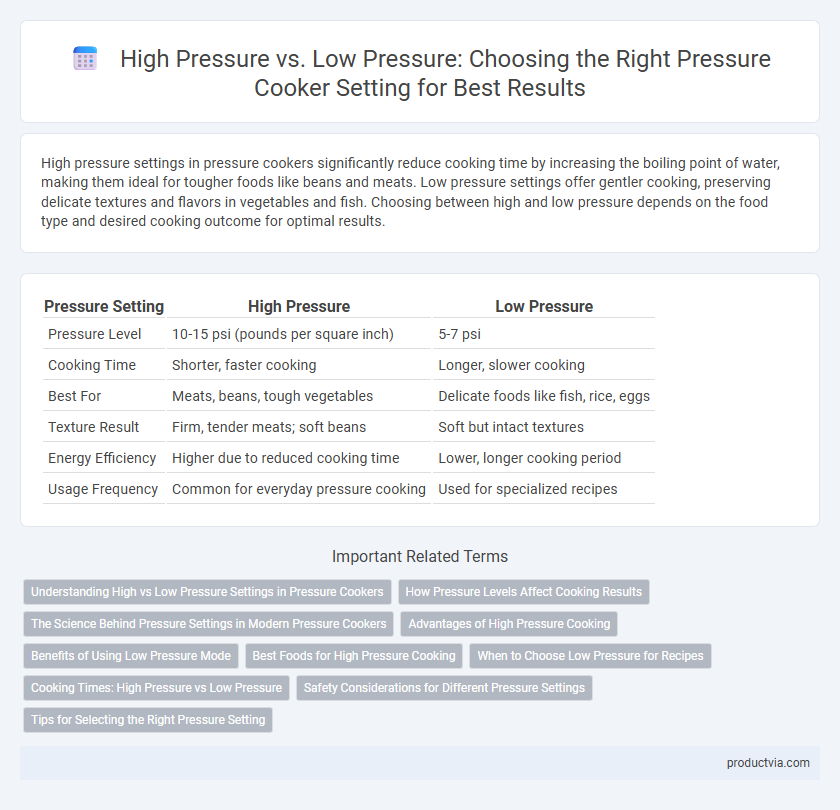High pressure settings in pressure cookers significantly reduce cooking time by increasing the boiling point of water, making them ideal for tougher foods like beans and meats. Low pressure settings offer gentler cooking, preserving delicate textures and flavors in vegetables and fish. Choosing between high and low pressure depends on the food type and desired cooking outcome for optimal results.
Table of Comparison
| Pressure Setting | High Pressure | Low Pressure |
|---|---|---|
| Pressure Level | 10-15 psi (pounds per square inch) | 5-7 psi |
| Cooking Time | Shorter, faster cooking | Longer, slower cooking |
| Best For | Meats, beans, tough vegetables | Delicate foods like fish, rice, eggs |
| Texture Result | Firm, tender meats; soft beans | Soft but intact textures |
| Energy Efficiency | Higher due to reduced cooking time | Lower, longer cooking period |
| Usage Frequency | Common for everyday pressure cooking | Used for specialized recipes |
Understanding High vs Low Pressure Settings in Pressure Cookers
High pressure settings in pressure cookers typically operate around 12-15 psi, resulting in faster cooking times and are ideal for tough meats and beans. Low pressure settings, usually around 6-8 psi, are gentler, preserving delicate foods like vegetables and seafood while preventing overcooking. Selecting the appropriate pressure helps optimize texture, flavor, and nutrient retention depending on the food type.
How Pressure Levels Affect Cooking Results
High pressure settings in pressure cookers accelerate cooking by raising the boiling point of water, resulting in faster tenderizing of meats and more efficient breakdown of fibers. Low pressure settings preserve the texture and flavor of delicate foods like vegetables and seafood, preventing overcooking and maintaining nutritional value. The choice between high and low pressure impacts moisture retention, cooking time, and overall dish quality, making it essential to match pressure levels with specific recipe requirements for optimal results.
The Science Behind Pressure Settings in Modern Pressure Cookers
High pressure settings in modern pressure cookers typically range between 10 to 15 psi, accelerating the boiling point of water above 212degF (100degC) and reducing cooking time by increasing heat transfer and steam penetration. Low pressure settings, usually between 5 to 7 psi, offer gentler cooking conditions ideal for delicate foods, preserving texture and nutrients by applying less intense heat and steam pressure. The science behind these settings relies on controlling vapor pressure to manipulate temperature and cooking speed, optimizing both safety and culinary results.
Advantages of High Pressure Cooking
High pressure cooking significantly reduces cooking time by increasing the boiling point of water, allowing food to cook faster while preserving nutrients and flavors. This method enhances heat penetration, tenderizing tough cuts of meat and dense vegetables more effectively than low pressure settings. High pressure also improves energy efficiency, making it an optimal choice for busy households seeking convenience without compromising food quality.
Benefits of Using Low Pressure Mode
Low pressure mode in a pressure cooker offers gentler cooking, preserving nutrients and texture in delicate foods such as vegetables and fish. Cooking at low pressure reduces the risk of overcooking and maintains more natural flavors, making it ideal for recipes requiring careful heat control. This setting also enhances safety by minimizing the intensity of steam release and pressure buildup, providing a controlled cooking environment.
Best Foods for High Pressure Cooking
High pressure settings in pressure cookers reach around 15 psi, ideal for tough cuts of meat, beans, and root vegetables that require faster cooking to break down fibers and enhance tenderness. Low pressure, typically 5-7 psi, suits delicate foods like fish, vegetables, and custards, preventing overcooking and maintaining texture. Using high pressure for foods like beef brisket, dried legumes, and potatoes significantly reduces cooking time while preserving nutrients and flavor.
When to Choose Low Pressure for Recipes
Low pressure settings in pressure cookers are ideal for delicate foods such as vegetables, seafood, and custards that require gentle cooking to preserve texture and nutrients. Recipes involving simmering or braising benefit from low pressure to avoid overcooking and maintain moisture. Using low pressure also reduces the risk of toughening proteins in meats and prevents overcooked grains from becoming mushy.
Cooking Times: High Pressure vs Low Pressure
High pressure settings in pressure cookers significantly reduce cooking times by increasing the boiling point of water, allowing food to cook faster and retain moisture more effectively. Low pressure settings require longer cooking durations but are ideal for delicate foods that benefit from gentle cooking to prevent texture breakdown. Choosing the appropriate pressure level depends on balancing speed with the food's texture and tenderness requirements.
Safety Considerations for Different Pressure Settings
High pressure settings in pressure cookers reach around 15 psi, enabling faster cooking times but requiring robust safety mechanisms to prevent accidents due to intense steam buildup. Low pressure settings typically operate at 5 to 7 psi, offering safer, gentler cooking suited for delicate foods while reducing the risk of overpressurization and valve malfunctions. Ensuring the pressure release valve and sealing gasket are in good condition is critical regardless of pressure level to maintain optimal safety during operation.
Tips for Selecting the Right Pressure Setting
Selecting the right pressure setting for a pressure cooker depends on the type and density of the food being cooked; high pressure, usually around 15 psi, is ideal for tough meats and dense vegetables to reduce cooking time significantly. Low pressure, typically around 6 to 8 psi, is better suited for delicate foods like fish, steamed vegetables, or recipes requiring gentle heat to prevent overcooking. Understanding the texture and moisture content of ingredients helps optimize cooking results and preserve nutrients when choosing between high and low pressure settings.
High Pressure vs Low Pressure for Pressure Cooker Settings Infographic

 productvia.com
productvia.com